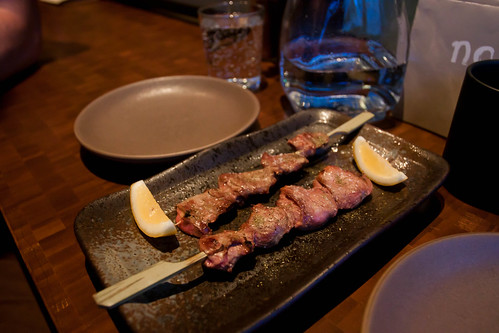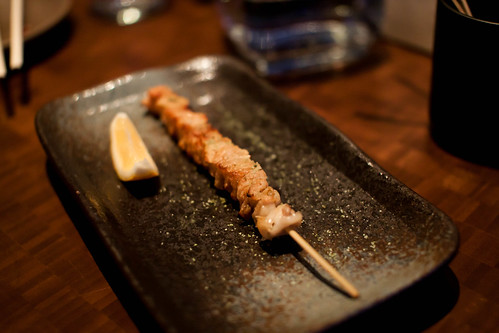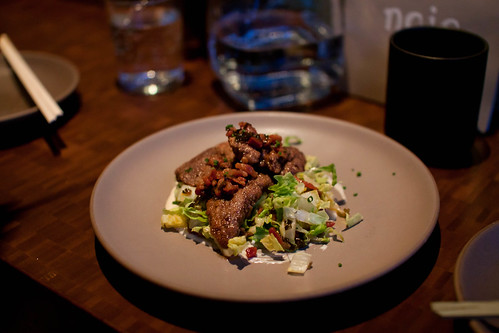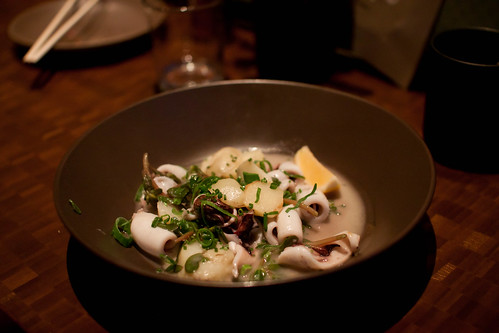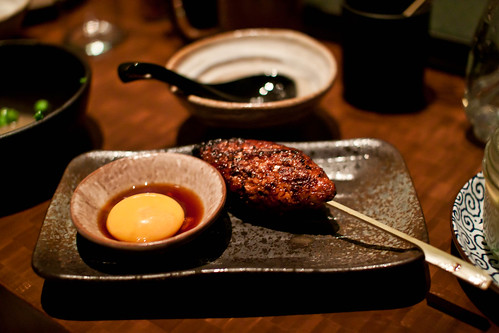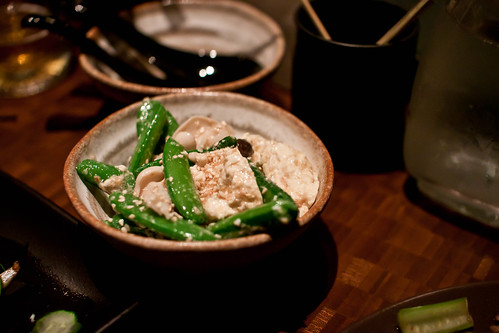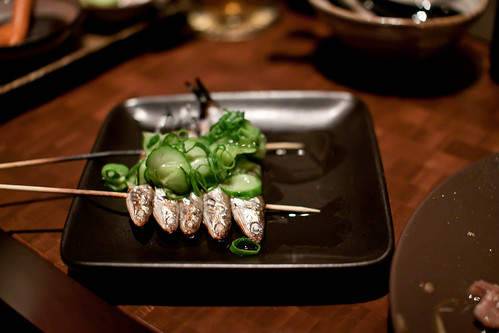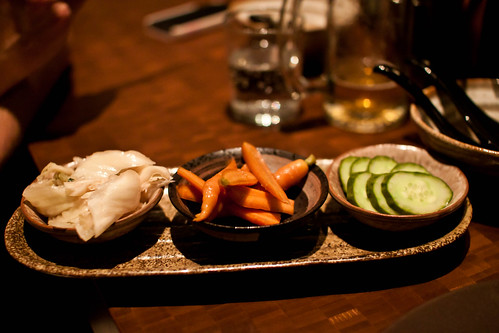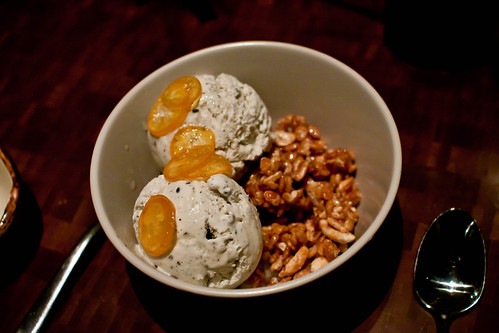To my delight, and cautious anticipation, we returned from Japan to a number of Izakayas opening in San Francisco. We loved these establishments in Japan, known for providing beer, sake and small noshing plates to their patrons. Roughly translated, the kanji for Izakaya 居酒屋 indicates sake-selling establishment (酒 – sake-ya). We already have Nombe in the Mission, Bushi-Tei Bistro and O Izakaya in Japantown, Halu in the Inner Richmond and Izakaya Sozai in our neighborhood, the Inner Sunset.* And perhaps because Izakayas are the New Big Thing, there appear to be a number of these bar-and-small-plates restaurants opening in our area over a fairly short span of time. And I of course want to check them all out. Kasumi is in the Outer Sunset on Ocean and has, thus far, received some somewhat tepid reviews. Chotto, in the Marina, is in a part of the city we don’t much like to frequent. So Nojo — in our old stomping grounds of Hayes Valley — won out. Chef Greg Dunmore reached the Bay Area by way of Atlanta, a graduate of the CIA in Hyde Park, NY. Dubbed a rising star chef in 2006 by the SF Chronicle, he first worked at the Michelin-starred Terra with Hiro Sone and Lissa Doumani who mentored him in Japanese cuisine. Sone soon asked him to become executive chef of Ame (Asian fusion at the St. Regis Hotel), where he stayed for 4 years and also earned a Michelin. After realizing he had a passion for Japanese yakitori and izakaya-style cooking, he’s now opened his own Izakaya-style establishment. Nōjō, the japanese word for farm (農場), brings together this passion and reflects his commitment to small farms and seasonal ingredients. It’s important to note however, that the food at Nojo seems to be distinctly Californian and heavily influenced by Japan, not the other way around.
We started out with some skewers, perhaps the most Japanese of the items on the menu. These chicken hearts — hatsu (ハツ) or kokoro (こころ) — were delicious, cooked perfectly, chewy and tender, the lemon providing welcome acid and the sansho (sichuan) pepper enabling that familiar tingly sensation about our lips.
Carefully trimmed to uniform square shapes, the torikawa (とり)かわ) had enough crispy and tender bits to provide textural interest; the matcha salt seasoning the skewer well, enhancing rather than distracting.
Rebā (レバー): One of the top dishes of the evening – even DD approved of these. Though I’ve loved chicken liver in all its forms, DD was especially enamoured of raw chicken liver (slightly cured with sake), having tasted it in Osaka with our new Japanese-American friend Hideki. These are decidedly cooked, sliced fairly thin and fried – and somehow – between the marinade, the crust and the accompaniments, the usual irony-livery-taste was masked well. The bacon studded throughout the salad lent beautiful smoky-salty notes, the vinegar a nice counterpoint to the rich livers, and the ponzu mayo a subtle and delicate creaminess that added another layer of beautiful complexity.
Alas, this was our least favourite of the evening. We had asked the server about dishes not to miss, and this had come up on her list. It had lots of potential — but was ultimately lacking in salt/ flavour. A squeeze of meyer lemon helped certainly but perhaps this dish suffered from the actual order in which it was served: right before this we had munched on the amazing liver dish, bursting with all sorts of flavours and textures; and prior to that the fabulous chicken skin skewer which was just a tad shy of being slightly too salty.
These gyouza (餃子) were a revelation. Having grown up consuming tons and tons of potstickers, or kuo tieh, these dumplings are not immediately high on my favourites list when we go to Japanese establishments. In fact, gyouza was something we noticeably did not eat when we journeyed to Japan – we just didn’t get around to making it a priority. I’m also used to pan-fried gyouza with the bottom crisped, the sides and interior flexible and tender, and sometimes even chewy. These dumplings were huge and arrived swimming in very hot steaming broth – which was definitely the highlight of the dish. Take chicken broth and reduce, reduce, reduce, (was there some tonkotsu broth, too?) — the result was an elevated, exceedingly flavourful liquid that stood far apart from the unfortunately pallid squid dish. Oh, and the large gyouza were delicious as well, slightly gingery, flecked with green onion.
Another fantastic dish, chawan mushi is a savoury egg custard steamed with dashi and other bits of fish, fowl and vegetables. Traditionally it contains chicken, shrimp, spinach or mitsuba, ginko nuts or chestnuts. This is a pared-down and decidedly San Francisco version, with dungennes crab (I imagine locally sourced from Sausalito-based TwoxSea), favas and green garlic. It was fabulous – the smokiness of the dashi coming through, and and the silkiness of the custard creamy and soft on the palate. Fava beans are a brilliant substitute and imho, better-tasting for the waxy ginko nuts, and the green garlic was subtly sweet and not overly pungent.
I was super-excited to see the tsukune paired with an egg yolk sauce, and made sure to ask our server whether it also contained some shoyu. We had the most astounding egg yolk dipping sauce in Kyoto at Roan Kikunoi and I had been hoping for a slightly similar facsimile here. Alas, it was just a little too much to hope for. Whereas at Kikunoi Roan the egg and soy reached the table mellow and already blended, having been marinating together (one of the chefs informed us) for something like 6 hours, at Nojo the egg yolk sat neatly in a pool of shoyu, and we were instructed to stir it up before dipping in the tsukune… which would have been fine except that the sauce turned out to be too salty. I thought about spitting out that first bite, thinking that perhaps it was the tare sauce that coated the meatball that was at fault. No – a quick finger swipe indicated that the egg sauce was the culprit – and I ended up eating the tsukune with just teeny dabs of egg. The tsukune was defintely fine on its own; and we were able to get a fuller taste of the tare in this skewer, compared to the others we had consumed: delicious and well-balanced: dark, smoky and full of umami.
Probably the least traditional, most fusion-y dish of all was this one – it looked like it had been confitted, and was as tender as it had been sous-vided. It was difficult to eat with chopsticks, and I ended up taking a knife and fork to it in order to get it into small enough pieces. The salad was cooked komatsuna (on the menu it’s listed as konomatsuna), a mustardy-type of brassicaceous green that reminded me a little of yau choi. The dressing tasted like it included soy, sesame oil and rice vinegar, and the combination of the salad with the nice tart kumquat and the rich duck was very tasty indeed. I did not taste the ginger so much, and the blend of soy and vinegar reminded me a little of Filipino chicken adobo. All in all a great dish – some folks might have preferred the skin to be a little more crisp, but I thought it was beautifully and deliciously fatty,.
Sourced from Oakland-based Hodo Soy, the tofu in this dish was (startlingly?) firm. Ever since I’ve had the amazing house-made tofu from Aburiya Raku and from Takemura in Japan, it’s been difficult to find similarly delicious and tasty product. I thought the tofu fine; I think I may want to try it unadorned and undressed. Overall this was a nice, light dish, palate-cleansing after so many rich plates, the snap peas fresh and crisp, the shimeji silky.
These little fishies are served bone-in and head-on. The vinegared cucumber salad (sunomono) is definitely a much needed accompaniment to the strong-flavoured fish, and is probably not for those who dislike prickly fishbones. They’re small enough to be palatable, but feeling the little pricklies going down one’s gullet may not be for everyone.
Finally, we had to finish with some tsukemono. These were beautifully and lightly pickled – the cabbage tasted of umeboshi and shiso; the carrots of vinegar and yuzu. The cucumbers were treated in rice bran – a nukazuke – and were light and crisp, perhaps the least pickled of all. This was a tasty and generously-portioned dish.
Probably not surprisingly, we only had room for one dessert, the signature Humphry Slocombe black sesame ice cream sundae. While tasty, especially if you manage to get a bit of everything — kumquats, ice cream, and peanut thunder — all in one bite, I wanted more sesame flavour in the ice cream. I found myself thinking longingly of goma dofu. “Peanut Thunder” is essentially a peanut brittle made with rice crispies (thunder snaps, crackles and pops?). It’s not that remarkable on its own, though I appreciate that it was not as sticky as regular brittle might have been. Nojo also had a lovely-sounding almond milk-yogurt panna cotta with matcha shortbread on the menu, and I’m now wishing that we had also ordered it last night.
We had a great server, casual and friendly, though she was not as familiar with Japanese food as one might expect. Several different staffmembers also came by over the course of the evening to ask if we had any questions, and at the end of the meal, which dishes were our favourites. Much has been written about how Chef Dunmore has brought the Japanese concept of kikubari to the States – a practice of service that roughly translates into being so extraordinarily sensitive to the needs and wants of your customers so that they want for nothing. At Nojo, the staff reportedly share both kitchen and serving duties, trying to emulate the practices of family-run establishments in Japan. Nojo’s a great new restaurant and we’re lucky to have Chef Dunmore behind the helm of a restaurant that’s a little more accesible than the fine dining of Ame and Terra. The food, with a few stumbles, is delicious and I definitely want to return again and again.
Nojo 231 Franklin StSan Francisco, CA 94102 (415) 896-4587 http://www.nojosf.com/
Nojo Photo set on Flickr here.
*Note: I’d been wanting to go to Ippuku in Berkeley for the longest time. They opened last year, I believe, and gained instant notoriety for having the cojones to offer raw chicken (in the US!) on the menu. Need to make that East Bay journey soon.

